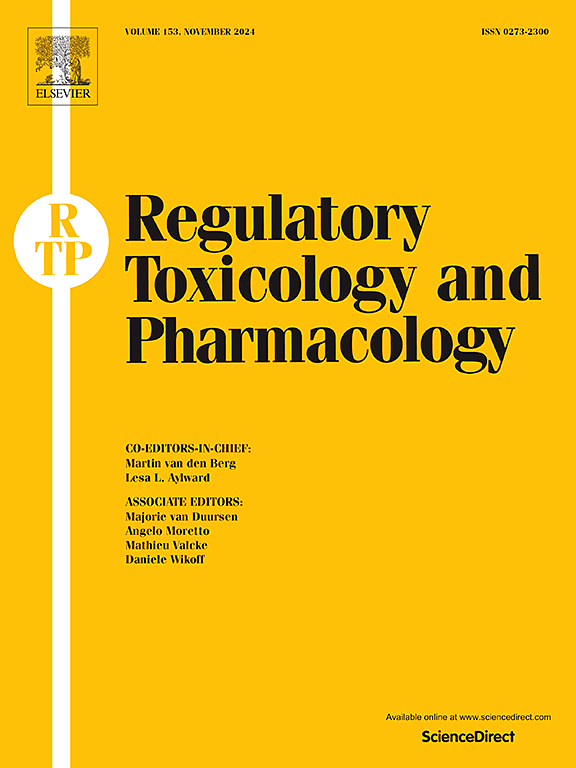Challenges and opportunities of read-across for the tumor promotion effects of microcystins
IF 3.5
4区 医学
Q1 MEDICINE, LEGAL
引用次数: 0
Abstract
The microcystins (MCs) are a family of cyclic oligopeptides toxins expressed in at least 30 cyanobacterial species and are liable to pose significant hazard to human health due to hepatotoxicity. Microcystin-leucine arginine (MC-LR) is the most extensively studied and toxic congener and classified as possibly carcinogenic to humans based on tumor promotion activity in the liver. Given the substantial toxicity data gaps for the MCs, read-across was assessed to evaluate the tumor promotion effects of a series of data-poor MC congeners based on in vivo information for MC-LR as the source molecule. Lines of evidence from in silico estimates of structural similarity, physico-chemical properties, hepatotoxicity, genotoxic and carcinogenicity were compiled to support the filling of data gaps. Uncertainties were evaluated according to scenario 4 of the European Chemicals Agency's (ECHA's) Read-Across Assessment Framework (RAAF). The read-across process followed a previously proposed harmonized framework to apply the common principles together with information from new approach methodologies (NAMs). Lines of evidence were consistent across the MC congeners and the uncertainties were found to be acceptable for data gap filling. Read-across strategies, with known caveats and restrictions, were shown to be applicable for large, complex molecules such as the MCs.
微囊藻毒素促肿瘤作用的解读挑战与机遇。
微囊藻毒素(MCs)是一种环状寡肽毒素家族,在至少30种蓝藻物种中表达,由于肝毒性可能对人类健康造成重大危害。微胱氨酸-亮氨酸精氨酸(MC-LR)是研究最广泛的毒性同源物,根据其在肝脏中的肿瘤促进活性,被归类为可能对人类致癌。鉴于MCs的毒性数据存在大量空白,我们基于MC- lr作为源分子的体内信息,评估了一系列缺乏数据的MC同系物的肿瘤促进作用。从结构相似性、物理化学性质、肝毒性、遗传毒性和致癌性的计算机估计中收集证据,以支持填补数据空白。根据欧洲化学品管理局(ECHA)解读评估框架(RAAF)的情景4评估不确定性。跨读过程遵循先前提出的统一框架,将共同原则与新方法方法学(NAM)信息一起应用。证据线显示了MC同系物之间的一致性,并且发现不确定性可以接受数据空白填充。具有已知警告和限制的读取策略被证明适用于像mc这样的大型复杂分子。
本文章由计算机程序翻译,如有差异,请以英文原文为准。
求助全文
约1分钟内获得全文
求助全文
来源期刊
CiteScore
6.70
自引率
8.80%
发文量
147
审稿时长
58 days
期刊介绍:
Regulatory Toxicology and Pharmacology publishes peer reviewed articles that involve the generation, evaluation, and interpretation of experimental animal and human data that are of direct importance and relevance for regulatory authorities with respect to toxicological and pharmacological regulations in society. All peer-reviewed articles that are published should be devoted to improve the protection of human health and environment. Reviews and discussions are welcomed that address legal and/or regulatory decisions with respect to risk assessment and management of toxicological and pharmacological compounds on a scientific basis. It addresses an international readership of scientists, risk assessors and managers, and other professionals active in the field of human and environmental health.
Types of peer-reviewed articles published:
-Original research articles of relevance for regulatory aspects covering aspects including, but not limited to:
1.Factors influencing human sensitivity
2.Exposure science related to risk assessment
3.Alternative toxicological test methods
4.Frameworks for evaluation and integration of data in regulatory evaluations
5.Harmonization across regulatory agencies
6.Read-across methods and evaluations
-Contemporary Reviews on policy related Research issues
-Letters to the Editor
-Guest Editorials (by Invitation)

 求助内容:
求助内容: 应助结果提醒方式:
应助结果提醒方式:


